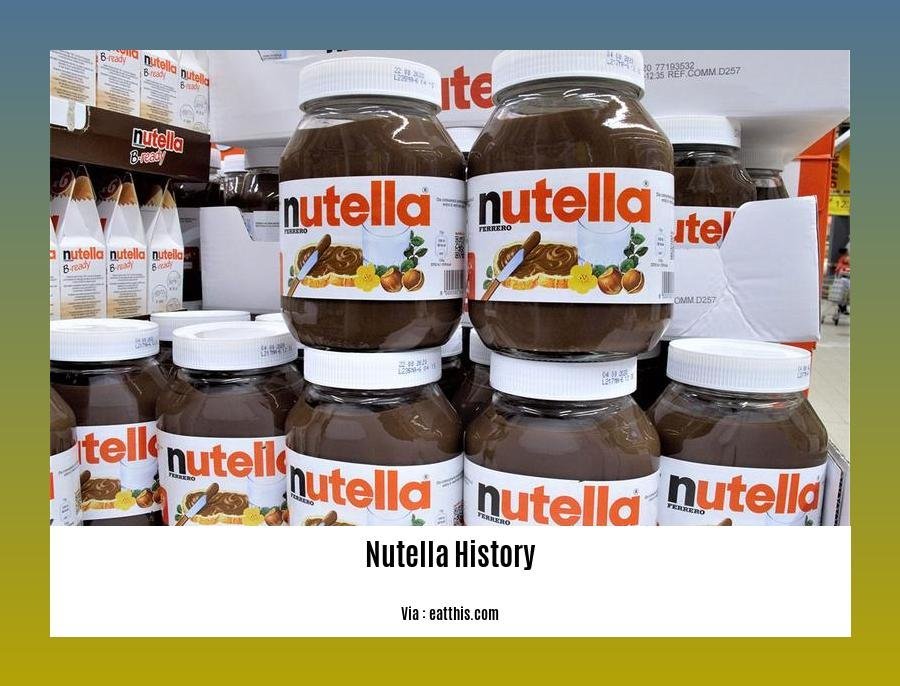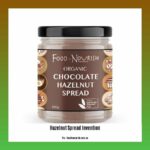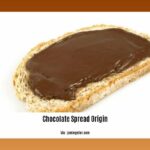Prepare to embark on a delectable journey through time as we explore [The History of Nutella: From Humble Beginnings to Global Triumph]. This iconic spread, beloved by generations, has a captivating story to tell. Join us as we trace Nutella’s origins, unravel its fascinating evolution, and celebrate its remarkable rise to global stardom.
Key Takeaways:
- Nutella is a hazelnut cocoa spread produced by Ferrero in Italy.
- It was first introduced in 1964 as a modified version of a recipe created in 1963.
- Nutella is made primarily of sugar and palm oil, with 13% hazelnut content.
- It contains a significant amount of saturated fat (10.4%) and processed sugar (58%).
- Nutella is marketed as “hazelnut cream” in many countries due to Italy’s legal definition of “chocolate cream,” which requires a higher cocoa solids concentration.
Nutella History
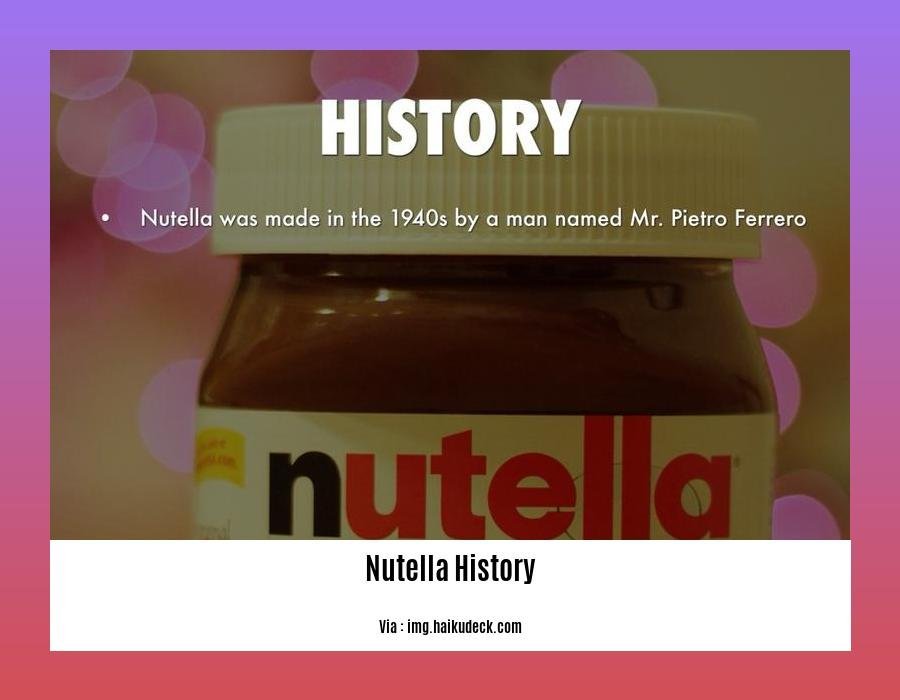
So, who’s ready to dive into the Nutella history? Let’s embark on a delectable journey through the world’s most beloved hazelnut spread!
In a nutshell (pun intended), Nutella’s tale begins in the heart of post-war Italy with a man named Pietro Ferrero. In 1946, Pietro invented a spread called “Pasta Gianduja,” a blend of hazelnuts and cocoa, to make the most of hazelnuts that were abundant in the region.
As the sweet treat gained popularity, Pietro’s son, Michele, rebranded it as Nutella in 1963. He tweaked the recipe to make it creamier and spreadable, and the rest, as they say, is history.
In 1964, Nutella hit the global stage, and its popularity exploded. Today, it’s a staple in pantries worldwide, enjoyed by millions for its rich, nutty flavor.
Nutella’s success can be attributed to several key factors:
-
Unique taste: Its creamy texture and blend of hazelnuts and cocoa make it irresistible.
-
Versatility: It’s not just for toast; Nutella can be enjoyed in countless ways, from crepes to smoothies.
-
Emotional connection: For many, Nutella evokes childhood memories and a sense of comfort.
Throughout its history, Nutella has faced some criticism for its high sugar and fat content. However, it remains a popular treat for people of all ages.
So, there you have it, the Nutella history. From its humble beginnings to its worldwide triumph, Nutella has earned its place as a beloved culinary icon.
For an in-depth look at the origins and history of chocolate hazelnut spread, you must click into the website. If you love and want to know more about the history of chocolate spread and hazelnut spread, hit the link.
Marketing Strategies and Global Domination
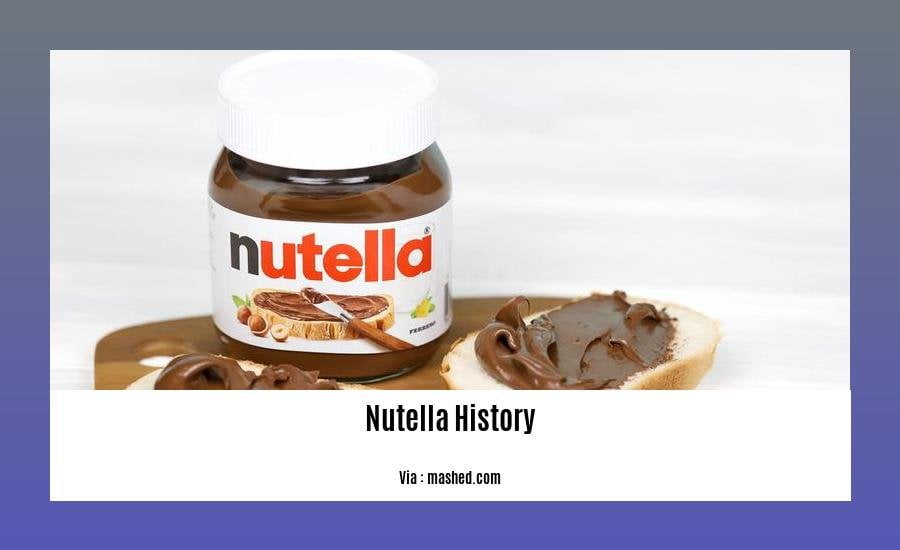
Nutella’s ascent to global dominance is a testament to its iconic taste, clever marketing strategies, and strategic global domination plan.
Clever Advertising
Nutella’s advertising campaigns have consistently highlighted its indulgent taste and versatility. Catchy slogans like “Wake up to Nutella” and “The taste of a happy morning” have resonated with consumers worldwide.
Expansive Distribution Network
To meet the growing demand, Nutella established production plants across the globe, ensuring its easy availability in various markets. This strategic distribution network has been crucial for its widespread success.
Brand Partnerships and Collaborations
Nutella has partnered with popular brands, such as crepe makers and bakeries, to promote its product and expand its reach. These collaborations have further solidified Nutella’s position as a beloved ingredient in various food preparations.
Key Takeaways:
- Nutella’s marketing strategies have focused on highlighting its taste and versatility.
- Strategic global domination through production plants worldwide has ensured its availability.
- Brand partnerships and collaborations have expanded its reach and solidified its position as a beloved ingredient.
Citation:
Nutritional Controversies
Nutella, the beloved hazelnut spread, has been a breakfast staple for generations. But behind its creamy facade lies a web of nutritional controversies.
Sugar Content:
The elephant in the room is Nutella’s staggering sugar content. A single 37-gram serving packs a whopping 21 grams of sugar – more than half of your daily recommended intake! This sugar rush can lead to weight gain, tooth decay, and even contribute to chronic diseases like type 2 diabetes.
Saturated Fat:
Nutella is also high in saturated fat, a type of fat that raises LDL (bad) cholesterol levels in your blood. High LDL cholesterol increases your risk of heart disease, stroke, and other cardiovascular issues. A 37-gram serving contains over 4 grams of saturated fat – almost a third of your daily limit.
Health Claims:
In 2012, Ferrero, Nutella’s parent company, was sued for falsely advertising the spread as healthy. Nutella’s marketing materials claimed it had “nutritional and health benefits.” However, a closer look at the label reveals a different story.
Key Takeaways:
- Nutella contains over 58% sugar by weight.
- It is high in saturated fat, which can increase LDL cholesterol levels.
- Ferrero has been sued for falsely advertising Nutella as healthy.
Citation:
Cultural and Culinary Impact
Nutella, the iconic hazelnut spread, has transcended its humble origins as a wartime creation to become a beloved global phenomenon. Its cultural and culinary impact is undeniable, inspiring countless culinary creations and evoking cherished memories.
Culinary Influence
Nutella’s unique flavor profile, with its blend of sweet hazelnuts and rich cocoa, has made it an indispensable ingredient in countless culinary creations. From classic pancakes and crepes to indulgent desserts, Nutella’s versatility shines. It has become a staple in homes and restaurants worldwide, inspiring chefs and home cooks alike to craft innovative and delicious dishes.
Cultural Significance
Beyond its culinary appeal, Nutella has also become a cultural touchstone, evoking nostalgia and comfort. Its iconic jar is instantly recognizable, and its creamy texture and sweet flavor have become synonymous with happy memories. Nutella has been featured in films, television shows, and countless cultural references, solidifying its place in popular culture.
Key Takeaways:
- Nutella’s unique flavor profile and versatility have made it an indispensable ingredient in countless culinary creations, from classic breakfast dishes to decadent desserts.
- The spread’s cultural significance extends beyond its culinary appeal, evoking nostalgia and comfort for countless individuals.
- Nutella’s iconic jar and distinctive flavor have become ingrained in popular culture, inspiring culinary creations and sparking cultural references.
Most Relevant URL Source
- The Surprising History of Nutella
FAQ
Q1: When was Nutella first created?
A1: Nutella’s origins can be traced back to 1946, created by Pietro Ferrero in Alba, Italy.
Q2: What is the main ingredient in Nutella?
A2: Sugar and palm oil are the main ingredients in Nutella, each exceeding 50%.
Q3: Why was Nutella created?
A3: Nutella was initially developed during World War II due to a shortage of cocoa.
Q4: When did Nutella gain global popularity?
A4: Nutella gained significant popularity in the 1960s after being introduced to Germany and later expanded into various markets, including Italy and the United States.
Q5: What is World Nutella Day?
A5: World Nutella Day is celebrated annually on February 5th, established in 2007 to commemorate the hazelnut spread’s worldwide appeal.
- Unveiling Bernhard Caesar Einstein’s Scientific Achievements: A Legacy in Engineering - July 15, 2025
- Uncover who is Jerry McSorley: CEO, Family Man, Business Success Story - July 15, 2025
- Discover Bernhard Caesar Einstein’s Scientific Contributions: Unveiling a Legacy Beyond Einstein - July 15, 2025
